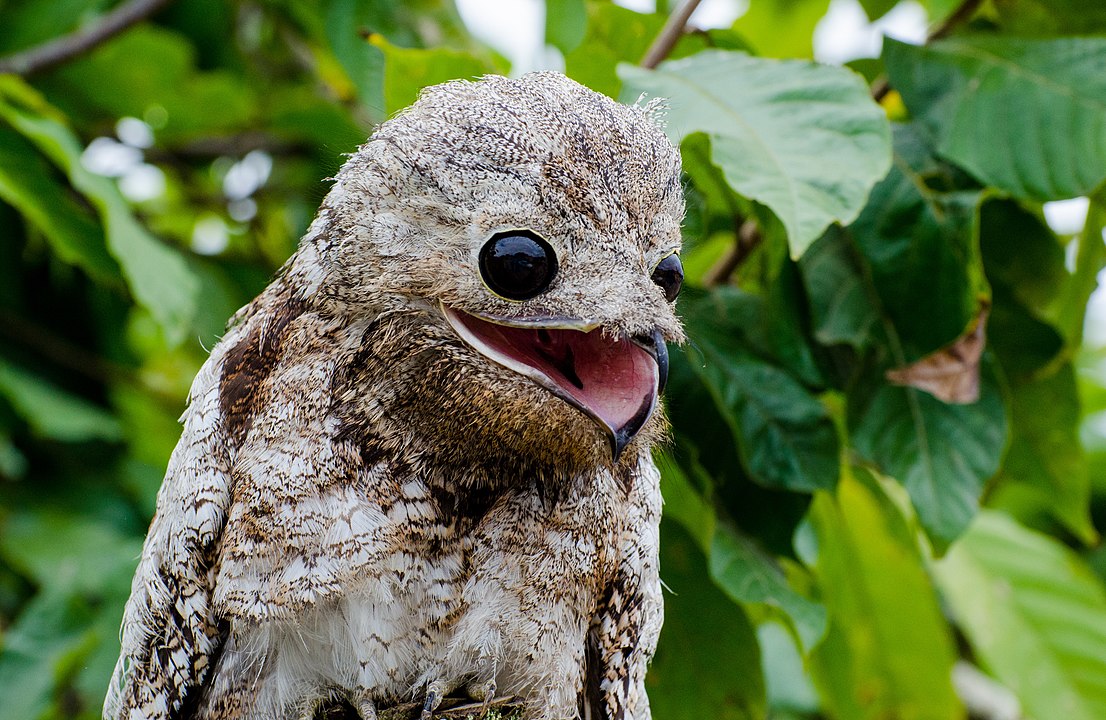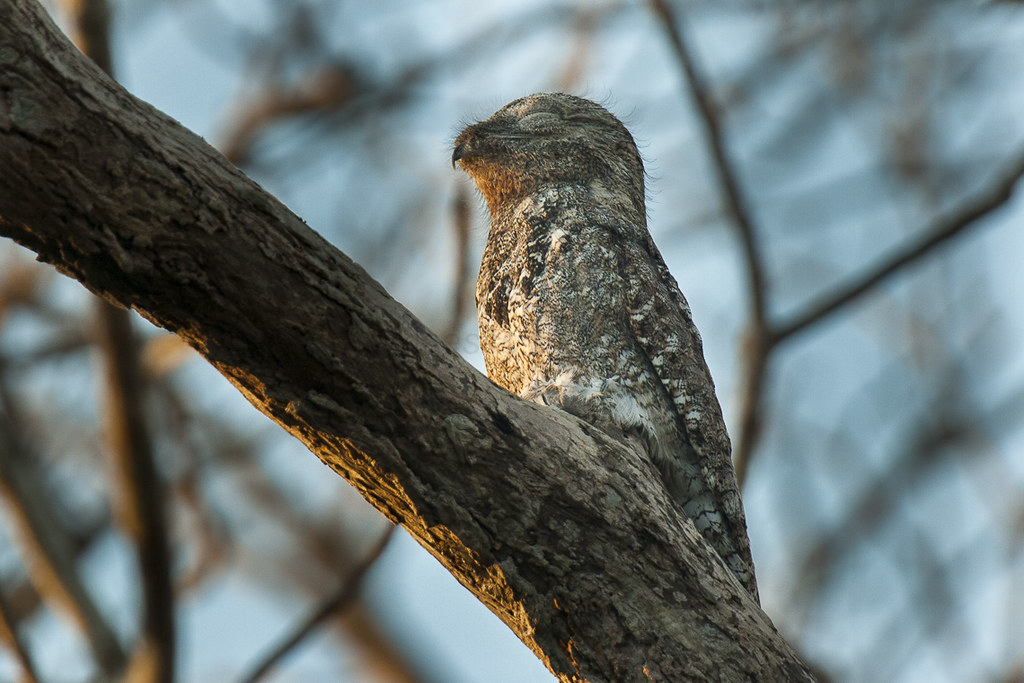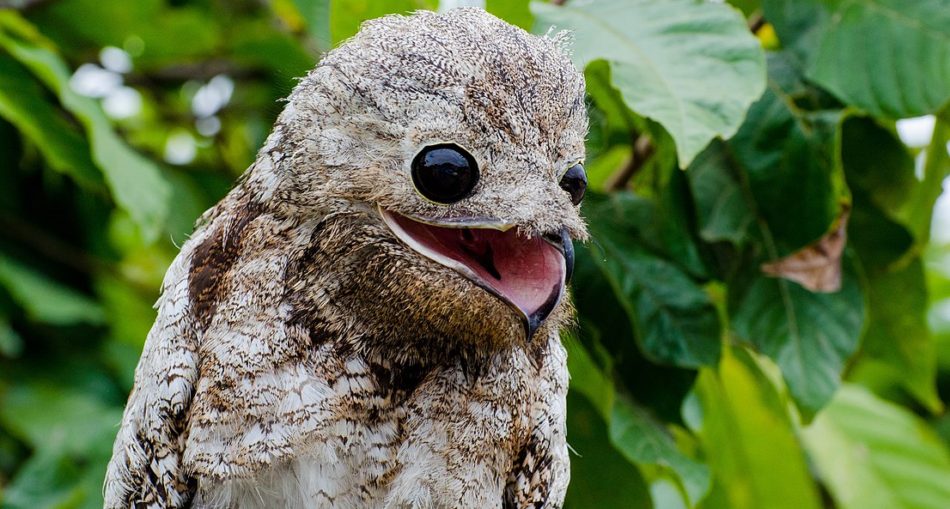Great Potoos are known for their excellent camouflaging abilities and their distinctive black eyes. They blend in almost seamlessly on their perches and can cause quite a bit of fright if you were to come across the near passerine, neotropical bird at night. The Great Potoo birds have been around for a while and have been fuelling nightmares with their creepy calls since. The Great Potoo is native to Mexico, Guatemala, Central America and in South America in countries such as Bolivia, Brazil and Guyana. However, scientists have found their fossils in France and Germany, dating back to a whopping forty (40) million years. Read on to find out about this unique and somewhat creepy bird.

The Great Potoo -Photo By Allissondias – Own work, CC BY-SA 4.0, https://commons.wikimedia.org/w/index.php?curid=69508043
Description Of The Great Potoo
A Great Potoo weighs about three hundred and sixty (360) to six hundred and fifty (650) grams. The young chicks typically weigh about to hundred and twenty (220) grams. Their wingspan ranges from seven hundred to eight hundred and four (700-804) mm. Compared to the rest of its body, the Giant Potoo has an enormous head. They also have very large, bulbous eyes, with yellow or light brown iris. Depending on the species they can be completely black. Great Potoos have relatively short, wide beaks which are useful in catching their prey. Their wings are oval-shaped and they have elongate tails, the feathers of which are a mixture of white, black, grey and even burgundy. With the exception of white bars running vertically, the tail is the same colour as the body. The young of the Great Potoo have shorter tails, lightly plumage, smaller bills and a lighter build.
Scientific Classification Of The Great Potoo
- Kingdom: Animalia
- Phylum: Chordata
- Class: Aves
- Order: Caprimulgiformes
- Family: Nyctibiidae
- Genus: Nyctibius
- Species: N. grandis
Habitat Of The Great Potoo
The habitat of potoos ranges from humid to semi-humid forested habitats. However, the Great Potoo takes to living in forest edges, clearings and dense lowland forests. You may also find them in plantations, open woodlands, meadows and even foothills up to one thousand and five hundred (1,500) metres high. Wherever the Great Potoo lives, there must be an abundance of trees where they are able to camouflage on perches. This is because the bird is often overlooked and easily mistaken for a part of the tree. They perch upright on these branches during the day, resting for the night’s work.

The Great Potoo – Photo by Francesco Veronesi
(https://www.flickr.com/photos/francesco_veronesi/16284594492)
Diet Of The Great Potoo
The diet of the Great Potoo consists primarily of large, flying insects such as katydids, crickets, grasshoppers and large beetles. As a nocturnal bird, the Great Potoo hunt at night. It would often capture bats and even smaller birds.
Behaviour Of The Great Potoo
Great Potoos are nocturnal creatures which means they rest in the day. During this time they can be found nesting in large trees about twelve (12) meters from ground level. They camouflage themselves by choosing similar coloured branches about twenty to thirty (20-30) centimetres in diameter. During the night they tend to frequent lower perches about one and a half metres (1.5) from the ground for seeking their prey. At an advantage under the cover of night, the bird lies in wait for prey. After spotting a prey, the Great Potoo rushes out from its perch, catch the prey and returns to the branch where it was previously camouflaged. Great Potoos may use a perch more than once during its nightly hunt.
Reproduction Of The Great Potoo
The Great Potoos breeds around February to August. Depending on the range of the bird, it can almost mate year-round. The birds build their nest as a slight depression in a thick branch of a tree about ten (10) metres above the ground. Nests usually contain one white, lightly spotted egg. The adults tend to stay near the nest during the day, depending on camouflage for the protection of their hatchlings. The offsprings are seen alone in the nest about a month after. After a fledging period which lasts about two (2) months, the offspring ventures off on its own and doesn’t return to its former nesting site. The nests of Great Potoos are preyed upon by the mantled howler monkeys, Geoffroy’s spider monkeys, white-headed capuchins and tayras and collared forest falcons.
Listen to the This! | Great Potoo’s Song | Eme Eme
About The Great Potoo
The species may seem unnatural, even for nocturnal birds but they really are your average birds, even if they are a bit lazy. They tend to rest all day on their perches, selected for good camouflaging features and hunt solely in the night. The Great Potoo is an odd, interesting bird so it’s only natural for there to be some befitting legend. The Shuar people of Ecuador believed that the bird is the sad spirit of a woman. It is said that her husband got angry with her and took off towards the sky, she tried to follow him but fell towards the earth. As she fell, she turned into the eerie Great Potoo bird. The haunting cries of the Great Potoo are said to be that of the wife for her husband, who is still stuck on the moon. What do you think? Let us know in the comments!
Article Reference
- https://en.wikipedia.org/wiki/Great_potoo
- https://animaldiversity.org/accounts/Nyctibius_grandis/
- https://honesttopaws.com/great-potoo-bird/







